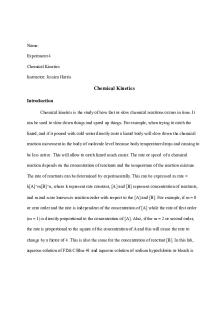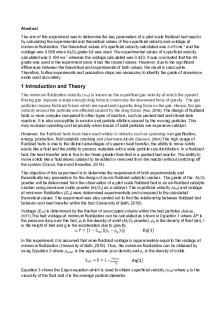Chemical Kinetic Lab Report PDF

| Title | Chemical Kinetic Lab Report |
|---|---|
| Author | Camille Otero |
| Course | Experimental Chemistry II |
| Institution | Indiana University - Purdue University Indianapolis |
| Pages | 2 |
| File Size | 84.6 KB |
| File Type | |
| Total Downloads | 49 |
| Total Views | 206 |
Summary
The fourth lab report for Chemistry 126...
Description
EXP 4: Chemical Kinetics Introduction Chemical kinetics is the study of reaction rate. The rate of a reaction depends on the concentration of reactants, a higher concentration causes a higher rate of reaction, and temperature of the reaction, the higher the temperature the higher the rate. In this lab the equation can be expressed like equation (1). m
n
rate=k [ ¿] [bleach ]
(1)
The “k” stands for the rate constant, “[]” stands for the concentration, and the “m,n” stand for the order of the reaction with respect to the concentration. To find concentration Beer’s Law, but before finding the concentration, the absorbance has to be found first. Its found with the absorbance equation (2). Absorbance=log(
100 ) T%
(2)
The “T%” stands for transmittance and the transmittance is gotten from the Spectronic 20. After finding the absorbance, Beer’s Law is used to find the concentration. It can be shown in equation (3). A=ℇbc
(3)
The “ A” stands for the absorbance, the “ ” is a given that is
1.38 ×105 M-1 cm-1, the “b” is
the wavelength which in this lab is 630nm, and the “c” is the concentration. The was arranged to be set to equal to the concentration (4). c=
A εb
(4)
With finding the concentration of the blue and the bleach , it will help reach the purpose of the lab, which is to determine the rate constant for the reaction with blue dye and the bleach, also know as NaOCl. Results and Discussion The concentration of the NaOCl was 1.343M to the first order and the concentration of blue was 0.53M also to the first order. The rate of the reaction came out to be 0.7 .The overall reaction can be expressed as (5). 1
1
rate=0.7 [ 0.53 ] [ 1.343]
(5)
For the results the concentration that was calculated for NaOCl makes sense, but the concentration of blue seems too low to be an acceptable concentration. Places where mistakes in this lab could have been made were not recording the transmittance at the right time, if big , uneven graphs were to be done the graph would not come out liner ,or in a perfect curve. Another place there was place to cause an error was in part d. If the bleach solution wasn’t diluted by half the data would look similar.
Conclusion At the end of the experiment the concentration of NaOCl was 1.343M and the concentration of blue was 0.53M. The calculations of the lab are significant because it helps find the rate constant for the equation which is 0.7.
Refrences Anliker,Breen,Nyugen, Experimental ChemistryII Laboratory Manual 2007-2011 pp19-27...
Similar Free PDFs

Chemical Kinetic Lab Report
- 2 Pages

Lab Report Chemical Composition
- 3 Pages

Chemical Kinetics - lab report
- 4 Pages

Lab 11 Chemical Kinetics Report
- 4 Pages

Static and Kinetic Friction lab
- 10 Pages

Kinetic Pre-Lab Questions
- 3 Pages
Popular Institutions
- Tinajero National High School - Annex
- Politeknik Caltex Riau
- Yokohama City University
- SGT University
- University of Al-Qadisiyah
- Divine Word College of Vigan
- Techniek College Rotterdam
- Universidade de Santiago
- Universiti Teknologi MARA Cawangan Johor Kampus Pasir Gudang
- Poltekkes Kemenkes Yogyakarta
- Baguio City National High School
- Colegio san marcos
- preparatoria uno
- Centro de Bachillerato Tecnológico Industrial y de Servicios No. 107
- Dalian Maritime University
- Quang Trung Secondary School
- Colegio Tecnológico en Informática
- Corporación Regional de Educación Superior
- Grupo CEDVA
- Dar Al Uloom University
- Centro de Estudios Preuniversitarios de la Universidad Nacional de Ingeniería
- 上智大学
- Aakash International School, Nuna Majara
- San Felipe Neri Catholic School
- Kang Chiao International School - New Taipei City
- Misamis Occidental National High School
- Institución Educativa Escuela Normal Juan Ladrilleros
- Kolehiyo ng Pantukan
- Batanes State College
- Instituto Continental
- Sekolah Menengah Kejuruan Kesehatan Kaltara (Tarakan)
- Colegio de La Inmaculada Concepcion - Cebu









